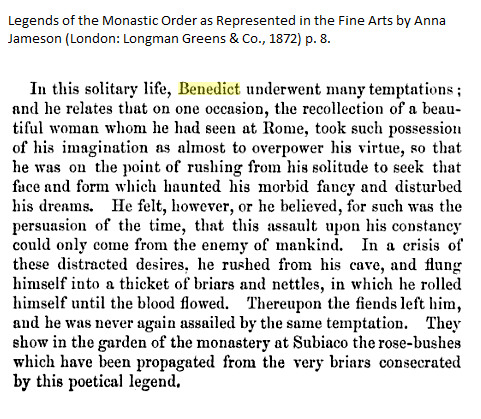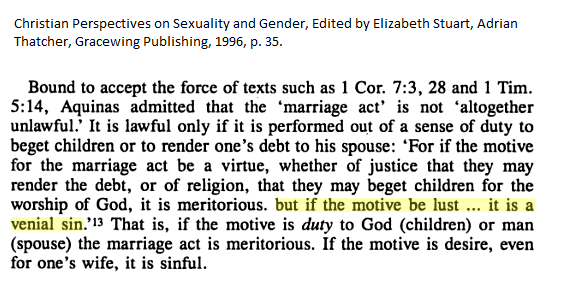In addition to issues already raised about Mark & Grace Driscoll’s book, Real Marriage, I have found other instances where material was not cited, cited with errors, or recycled from other books. Today, I want to examine pages 115-117 from Real Marriage. First I provide the sentence from the Driscolls’ book and then the apparent source. The sentences in Real Marriage are provided in the order they are written in the book. I have provided screen caps of 2012 Real Marriage and Leland Ryken’s 1986 book Worldly Saints at the end of this post. Much of this material appears to come from Ryken’s book published by Zondervan without citation. Driscoll is aware of Ryken’s book. He recommended Worldly Saints in a 2002 sermon and on the Resurgence website just last year. Other books are also used without citation which I point out below.
From page 115 of Real Marriage:
Tertullian (AD 155– 220) and Ambrose (AD 340–397) were said to prefer extinction of the human race to continued sexual intercourse.
On page 40 of Worldly Saints:
Tertullian and Ambrose preferred the extinction of the human race to its propagation through sin, that is, through sexual intercourse.
From Real Marriage (p. 115):
Origen (AD 185– 254) was so convinced of the evils of sexual pleasure that he not only allegorized the Song of Songs but also took a knife and castrated himself.
From Worldly Saints (p. 40):
Origen took Matthew 19:12 so literally that he had himself castrated before being ordained.
Real Marriage (p. 115):
Gregory of Nyssa (AD 335– 394) taught that Adam and Eve were created without sexual desire, and if the fall had not occurred, the race would have reproduced itself by some harmless mode of vegetation.
Worldly Saints (p. 41):
Bishop Gregory of Nyssa claimed that Adam and Eve had originally been created without sexual desire, and if the Fall had not occurred, the human race would have reproduced itself by some harmless mode of vegetation.
Real Marriage (p. 115):
Chrysostom (AD 347– 407) said that Adam and Eve could not have had sexual relations before the fall.
Worldly Saints (p. 41):
Chrysostom said that Adam and Eve could not have had sexual relations before the Fall.
Real Marriage (p. 115):
Jerome (AD 347– 420) threw himself into thorny brambles to overwhelm himself with pain when he began to desire a woman sexually. He also beat his chest with a stone to punish himself for feeling sexually tempted.
From S. Drury, Terror and Civilization: Christianity, Politics, and the Western Psyche, (see image) (p. 96):
St. Jerome beat his chest with a stone to drive away the evil desire he had for a dancing girl he saw in Rome…Saint Benedict stripped himself naked and rolled around in thorny bushes to chastise his body for its lusts.
While I can’t be dogmatic about it, I can’t find a story about Jerome in the thorn bushes. However, there are multiple sources which describe Benedict’s naked roll in the thorns. For instance, an account from Legends of the Monastic Order as Represented in the Fine Arts by Anna Jameson has Benedict sending temptation away via his painful ordeal:

Real Marriage (p. 115):
And he (Jerome) believed that a husband was guilty of adultery if he engaged in unrestrained sexual passion with his wife. 17
There is a footnote here which points to William Cole’s 1966 book Sex in Christianity and Psychoanalysis and published by Oxford University Press. Cole refers to a catechism which cites Jerome as follows:
A wise man ought to love his wife with judgment, not with passion. He will govern the impetuosity voluptuous impulses, and will not be hurried into indulgence. There is no greater turpitude than that a husband love his wife as an adultress.
While Driscoll’s interpretation of Jerome is fair, a fuller reading indicates Jerome’s grudging approval of marital sex, within reason:
It is disgraceful to love another man’s wife at all, or one’s own too much. A wise man ought to love his wife with judgment, not with passion. Let a man govern his voluptuous impulses, and not rush headlong into intercourse.
There is nothing blacker than to love a wife as if she were an adulteress. Men who say they have contracted marriage and are bringing up children, for the good of their country and of the race, should at least imitate the brutes, and not destroy their offspring in the womb; nor should they appear in the character of lovers, but of husbands.
Real Marriage (p. 115):
Augustine (AD 354– 430) was sexually active before his conversion and later decided that sex within marriage was not sinful, though the lust and passion associated with it was sinful. Because of this, he often commended married couples for not engaging in sex and referred to it as a form of animalistic lust. 18
This sentence is footnoted appropriately.
Real Marriage (p. 115):
Saint Francis made women out of snow and then caressed them in order to quiet the lust that burned in him.
From Drury’s Terror and Civilization (p. 96):
Saint Francis tried to cool the lust that burned within him by caressing figures made of snow.
As noted by this blogger (who contacted Driscoll to find his source with no reply), this telling of the Saint Francis legend appears to be incorrect. There is a legend involving St. Francis and snow figures but the story is different in very important ways. An important source of St. Francis legends is the work of Bonaventure who quoted from Celano. The legends of St. Francis as recorded by Celano are here. The story involving snow figures is as follows:
How the devil, calling to Francis, tempted him with lust, and how the saint overcame the temptation
116 At the hermitage of the brothers at Sartiano, he who is always envious of the children of God, presumed to do the following against the saint. For seeing the saint continuing to increase in holiness and not neglecting today’s profit for yesterday’s, he called to Francis at prayer one night in his cell, saying three times: “Francis, Francis, Francis.” He answered, saying: “What do you want?” And the other: “There is no sinner in the world whom the Lord will not forgive if he is converted; but whoever destroys himself by harsh penance will not find mercy forever.” Immediately the saint recognized the cleverness of his enemy by a revelation, how he was trying to bring him back to lukewarmness. What then? The enemy did not stop short of inflicting upon him another struggle. For seeing that he could not thus conceal his snare, he prepared another snare, namely, the enticement of the flesh. But in vain, for he who had seen through the craftiness of the spirit could not be tricked by the flesh. The devil therefore tempted him with a most severe temptation of lust. But the blessed father, as soon as he noticed it, took off his clothing and beat himself very severely with his cord, saying: “See, brother ass, thus is it becoming for you to remain, thus is it becoming for you to bear the whip. The tunic belongs to the order; stealing is not allowed. If you want to go your way,
117 But when he saw that the temptation did not leave him in spite of the scourging, even though all his members were marked with welts, he opened his cell and went out into the garden and cast himself naked into a deep pile of snow. Then gathering handfuls of snow, he made from it seven lumps like balls. And setting them before him, he began to speak to his body: “Behold,” he said, “this larger one is your wife; these four are your two sons and your two daughters; the other two are your servant and your maid whom you must have to serve you. Hurry,” he said, “and clothe them all, for they are dying of cold. But if caring for them in so many ways troubles you, be solicitous for serving God alone.” The devil then departed quickly in confusion, and the saint returned to his cell glorifying God. A certain spiritual brother, who was praying at the time, saw the whole thing by the light of the moon. But when the saint found out later that this brother had seen him that night, he was greatly distressed and commanded him to tell the thing to no one as long as he lived in this world.
While I am not an expert on St. Francis, my research into this story leads me to believe that both Drury and Driscoll are wrong about the story (and it is a story with no way to know if it is true). In this case, Driscoll’s copying seems to have led him into presenting a false picture of the St. Francis legend.
Real Marriage (p. 115):
Thomas Aquinas (AD 1225– 1274) taught that sex was only permissible for purposes of procreation. Aquinas saw sexual intercourse as duty alone. Anything beyond this was immoral. He wrote, “For if the motive for the marriage act be a virtue, whether of justice that they may render the debt, or of religion, that they may beget children for the worship of God, it is meritorious. But if the motive be lust . . . it is a venial sin.” 19
The footnote here goes to an online version of Aquinas’ Summa Theologica. However, the section in Real Marriage looks very much like this section from this book:

Real Marriage (p. 115)
Early in the sixth century, Pope Gregory the Great wrote that although marriage was not sinful, “conjugal union cannot take place without carnal pleasure, and such pleasure cannot under any circumstance be without blame.” 21
This sentence is appropriately footnoted.
Real Marriage (p. 116):
The Church eventually began to limit the days on which sex was permissible and continued adding days until half the year or more was prohibited, with some priests going so far as to recommend abstinence from five to seven days a week.
Worldly Saints (p. 41):
The Church kept multiplying the days on which sex was prohibited for married people until half the year or more was prohibited, with some writers going so far as to recommend abstinence on five of the seven days of the week.
Real Marriage (p. 116):
The Catholic Church’s view through the Middle Ages was that sexual love, both in and out of marriage, was evil.
Worldly Saints (p. 40):
The dominant attitude of the Catholic Church throughout the Middle Ages was that sexual love itself was evil and did not cease to be so if its object were one’s spouse.
Real Marriage (p. 116):
By the fifth century priests were forbidden to marry, which has, at least in part, resulted in a global scandal as sexually unhealthy and unholy men entered pastoral ministry.
Worldly Saints (p. 40):
By the fifth century clerics were prohibited from marrying,
I am going to stop there because I think this is enough to indicate the nature of the problems. While this is a relatively short section of Real Marriage, it seems clear that at least Leland Ryken and Shadia Drury should have been cited. Some of the material matches up exactly with the sources I have supplied while other information is included without any sourcing. In at least two cases, copying appears to have compromised the facts.
Worldly Saints – Image pages 40-41; reference to sources on church history (Although Ryken did not footnote each sentence in his book, he supplied his sources for the discussion in a footnote)
Real Marriage – Image pages 115-116